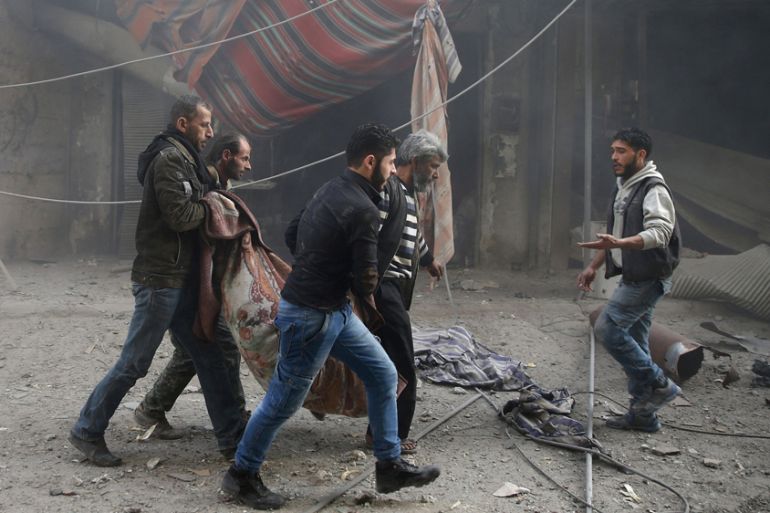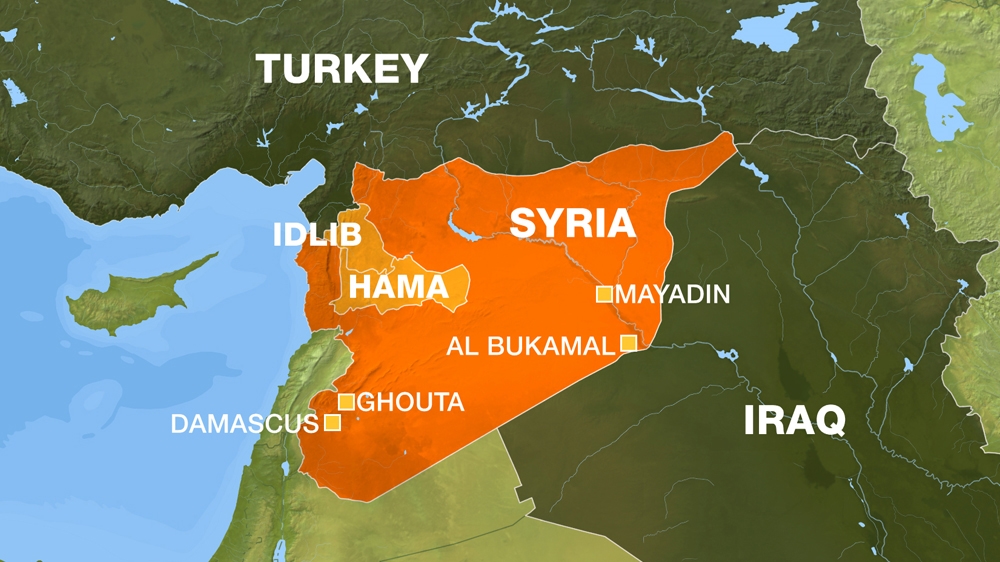Will Syria see a political solution in 2018?
Over the past seven years, the fighting that once spanned the entirety of Syria has now been relegated to a few areas.

After nearly seven years of conflict, the war in Syria has all but subsided.
The fighting and bloodshed that once spanned the entirety of the Arab nation have been relegated to a few areas, raising the question of whether the country will see at least some semblance of stability in 2018.
With the help of Russia and Iran, forces loyal to Syrian President Bashar al-Assad transformed the fight against armed opposition groups aiming to overthrow the government into a “war against terrorism”.
|
|
A relentless Russian bombing campaign, and the deployment of tens of thousands of Iranian-backed troops to aid Assad’s men, slowly dealt the armed opposition one blow after another.
The rise of al-Qaeda linked groups and the Islamic State of Iraq and the Levant (ISIL) allowed the Syrian government to turn the narrative of a revolution against the government into a battle against “extremist” groups.
But while violence has significantly decreased and is expected to continue to do so in 2018, political analysts say the country is unlikely to see a meaningful, political solution to the conflict any time soon.
The lack of a political solution, they say, will mean that violence will continue.
“The Syrian government seems to be winning, in a slow, painful, imperfect sort of way. Large areas of the country will remain beyond the control of Damascus for a long time still, and violence could ebb and flow for years,” Aron Lund, a fellow with The Century Foundation think-tank, told Al Jazeera.
“The various peace processes may succeed in tuning down the violence in various ways, but a genuine political transition seems off the table. It probably always was,” he said.
Where is fighting taking place and why?
In May 2017, Russia, Iran, and Turkey – which supports the armed opposition – agreed to implement a plan for “de-escalation zones“. The plan was aimed at halting fighting and offering safety to civilians in those areas.
The areas consist of Idlib province, East Ghouta, northern Homs province and the country’s south.
But the Syrian government and its allies have not abided by the agreement and continue to target all areas included in the deal apart from the south.
The most severe fighting is now focused in three main areas:
– Eastern Ghouta – a rebel-held enclave near the government-controlled capital Damascus
– The Idlib-Hama region in northwest Syria
– The country’s far eastern region along the Euphrates where remnants of ISIL (also known as ISIS) continue to operate

For the Syrian government, the proximity of Eastern Ghouta to the capital Damascus makes it a key target.
The area is under the control of groups loyal to the Free Syrian Army (FSA), a loose conglomeration of armed brigades made up of Syrian army defectors and ordinary civilians, which receive financial and logistical support from the United States, Turkey, and several Gulf countries.
Since 2013, the government has maintained a suffocating siege on the area in an effort to weaken the rebel groups and continues to shell it despite the so-called de-escalation agreement.
In Idlib province, however, a former al-Qaeda affiliated group, known as Hay’et Tahrir al-Sham (HTS), dominates.
While HTS is centred mainly in the city, some 40 armed groups affiliated with the FSA also have control in other areas of the province, according to Omar Kouch, a Syrian political analyst based in Turkey.
Kouch estimates that HTS men number around 10,000, while FSA-linked fighters amount to some 30,000.
“The pretext that the Syrian government is using to attack Idlib is that there is HTS. But Idlib is very important to the regime and to Russia because Turkey also wants to deploy its forces there based on the de-escalation agreement,” Kouch told Al Jazeera from Istanbul.
“Thus, the agreement is not being respected – shelling on Idlib did not stop for a single day.”
The Idlib-Hama region is strategically important for the government and Russia as it is near to the coastal region where the Russian-operated Syrian Khmeimim airbase sits.
The third area witnessing bouts of violence is Syria’s far-eastern region along the Euphrates – between al-Mayadin and al-Bukamal – where ISIL remains potent and continues to launch attacks, challenging Assad’s forces and US-backed Kurdish forces, which have control over much of Syria’s north and east.
Is a political solution imminent?
On the international level, there are two main tracks of diplomacy centred around finding a peaceful political solution to the conflict.
The first is the UN-sponsored talks in Geneva, Switzerland, which began in 2012 and are ongoing. The main aim of the track has been to achieve a political transition in Syria, but it has consistently failed to achieve that goal.
The main obstacle has been the fate of Assad: while the Syrian government has consistently refused to entertain any prospect of Assad stepping down, the armed opposition has made clear its position that Assad’s removal is the only option for peace.
Russia’s military intervention in 2015 changed the balance of power on the ground and placed Assad’s forces firmly in control.
It then largely took over the diplomatic process after its air force helped the Syrian government and allied Iran-backed fighters retake eastern Aleppo from the armed opposition in December 2016.
In 2017, the Kremlin decided to launch another diplomatic track – in Astana, Kazakhstan – with the sponsorship of Turkey and Iran.
The Astana track brought fighters from armed groups to the negotiating table for the first time and said it aimed to achieve a military ceasefire, address the issue of detainees in government prisons, and facilitate humanitarian aid to civilians.
But the main development to come out of the Astana talks has been agreement on the so-called de-escalation zones that have largely been unsuccessful.
Most recently, Russia opened a new track for talks at the Black Sea resort of Sochi, which it called the “Syrian national dialogue congress”, set to take place in late January.
“The Russians want to frame the conflict in Syria as a civil war. That’s why they gave (the Sochi talks) that name. They’re trying to enforce the idea that the talks will reconcile between sects that are at war in Syria and that all that is needed are a few changes in the constitution and elections, which Assad will be able to run for,” said Kouch.
“The conflict in Syria is a conflict over political transition, but the Russians are trying to change the narrative. That’s why Geneva was sidelined and Sochi will now be the new political track,” he added.
Kouch believes the meeting in Sochi will be “as though Syrians have moved past the phase of war and must now enter the phase of peace and reconstruction”.
Future scenarios
While Russia and the Syrian governments may succeed in enforcing a military solution and significantly decrease levels of violence, the opposition says that any plan that excludes a political transition will inevitably fail and will hinder Assad’s ability to regain full control over the country.
Mohammad Sabra, the former chief negotiator for the largest Syrian opposition bloc, the High Negotiations Committee (HNC), says that while he expects there will be less bloodshed in 2018, the “revolution will manifest itself in different forms if Assad is not removed from his position”.
“The rise of the armed opposition came one and a half years after the revolution began. It’s not about the armed groups – it’s about the demands of the Syrian people,” he told Al Jazeera from the United Arab Emirates.
The armed opposition continues to receive logistical support and funding from the United States, Turkey and several Gulf countries, albeit at lower levels.
James Gelvin, a professor of the Middle East at the University of California, Los Angeles (UCLA), believes that aid for opposition groups will continue to decline, but will not end, meaning the rebels will be able to continue fighting for some time to come.
“Most of the territorial gains the government has made during the past two years have been accomplished by the Lebanese group Hezbollah, Iranian units, Iranian-trained and controlled militias, and private militias, not by government forces per se,” Gelvin told Al Jazeera, explaining that the Syrian government forces are worn out.
“The former Arab League and United Nations envoy, Lakhdar Brahimi, was correct several years ago when he predicted the Syrian civil war would end with the ‘Somalization’ of Syria.
“Like Somalia, Syria will have an internationally recognised government and permanent representation at the United Nations,” Gelvin explained.
“However, like the government of Somalia, the government of Syria will reign but not rule over the entirety of its internationally recognised borders.”